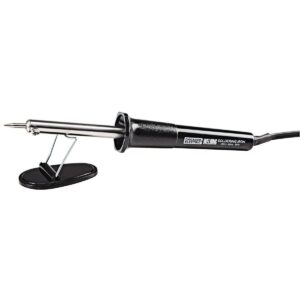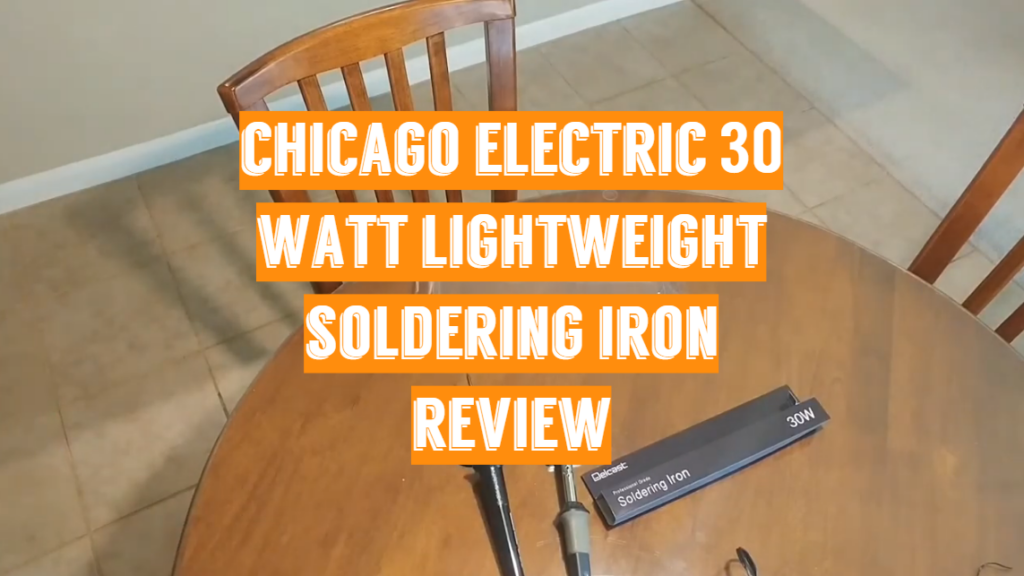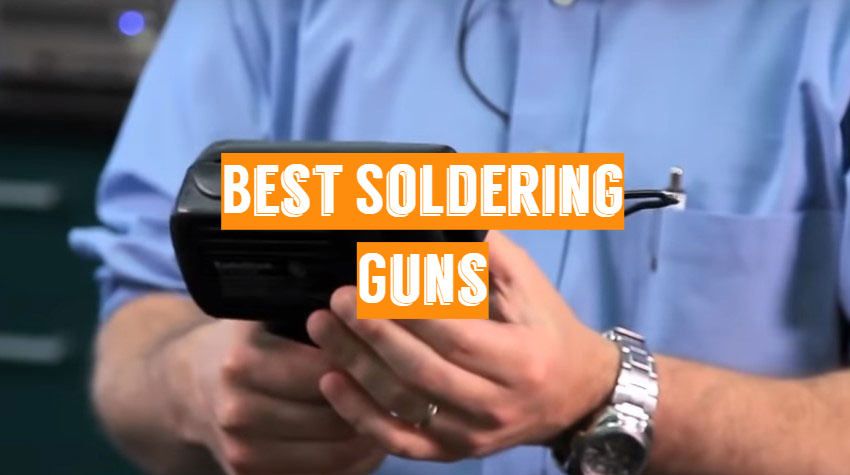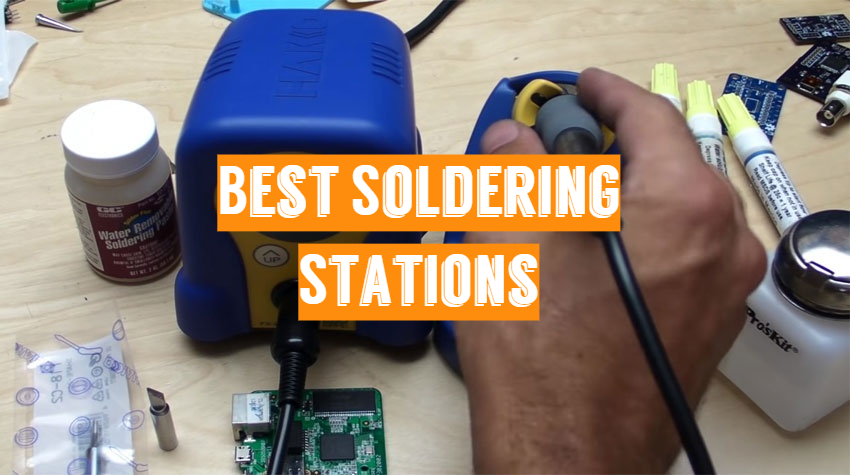For delicate soldering work, this featherweight iron has a pencil-style handle to offer you more leverage. The solder pen stand holds the hot iron off the work surface. With both hands on the workpiece, you can do thorough soldering work.

- Solder pen stand keeps the hot iron off your work surface – lets you do detail soldering work with both hands on the workpiece
- Chrome-plated steel tip
- Wattage (watts): 30
This soldering iron heats up within 30 seconds. The maximum temperature range is 735F. It weighs less than 0.4 pounds. The power cord’s length is quite satisfying – up to 4 ¾ ft.
This tiny soldering iron had a perfect tip and had no trouble welding for hours. It’s not customizable, but for soldering purposes, it gets very hot. Overall, for occasional use, it can be recommended to anybody who wants a soldering iron. It has a good point on it so you can get soldering accuracy. This soldering iron heats up easily.
Performance
The Chicago Electric 30-Watt lightweight soldering iron could be a good choice for light-duty jobs and small electronics tasks. It should be perfect to weld ordinary through electrical components and thin wires, including the thin legs on DC power plugs and sockets. To retain its temperature, a basic iron depends on thermal equilibrium.
A few examples of how you can use Chicago Electric 30-watt lightweight soldering iron:
- Attach Arduino chips;
- Repair toy railroads;
- Solder wires on Christmas decorations;
- Fix remote control devices;
- Fix a microwave display;
- Circuit boards;
- Solder in tight spots;
Possible technical issues
This soldering iron uses 3 different tips. They are flimsy and may burn easily after one or two uses.
The tips are uniquely colored due to how you add them to the joints that you are welding. And if you can place a flat region of the tip against the joint, you get increased heat transfer.
It’s best to make a tip with the same width as the old tip. The freshly produced tip ends in the wire brush where they slide into the pistol and then tighten the nuts. Rub the welding tip with wire, flux it, and tin it.
Recommendations for users
The optimal temperature to use is the one that is as minimal as practicable but also remaining hot enough to get the job done, as a general rule of thumb. In other terms, if the temperature necessary to do the function is 370 degrees Fahrenheit or higher, set the temperature to exactly 370F. This would help to prolong the life of your instruments and prevent any computer devices from getting damaged.
When the iron is heated to the required temperature, pick up the iron in one hand by the handle and keep in the other hand a sheet of solder. To heat them, keep the hot iron to the spot where the two metal components would touch for around a second. You want the metal pieces to heat up, not the welder itself.
Place the solder on the hot elements, next. It would leak through the holes it wants to cover when the solder melts. Continue to feed until a large volume is melted in the solder. You don’t want to get so much solder either, while you need plenty to form a stable link. From project to project, the correct quantity can differ. Usually, this won’t require longer than a handful of seconds.
Pros and Cons of Chicago Electric 30 Watt Lightweight Soldering Iron
Pros
- The cheapest soldering iron;
- Good for small and basic soldering jobs;
- Easy to set up and apply;
- Small, lightweight and portable;
- Good for hobbyists and novice users;
- Ideal for small hands;
- Comes with a stand;
- 90-day warranty;
- Easy to Use;
- Quality;
- Durability.
Cons
- The handle gets hot easily;
- Average build;
- Hard to tin;
- Flimsy tips;
- The replacement tips are hard to find;
- The cord not flexible.
For doing simple work, this soldering iron might be great. Even if it splits at this price stage, there is a strong probability that you would be happy due to the price tag.
The Buyer’s Guide
When picking a new 30-Watt soldering iron you should consider such things:
Wattage
You can pick up a soldering iron with a power source of at least 30 watts. Low-wattage soldering iron requires time to heat up and keeping the temperature is not reliable.
Temperature control
This is a positive feature since various jobs involve the temperature of a different iron.
Tip compatibility
The iron tips should be replaceable and a large range of tips should be consistent with the iron. There are various tips for different kinds of work, of different sizes. You should also remember the price of the tips while buying a welding iron. Only tips from the same manufacturer are compatible with certain soldering irons.
Holding stand
This is essential so that when you function, you have somewhere to put the hot iron in.
Applications
Do you sometimes require a soldering iron for minor repairs/jobs? Or do you also use a soldering iron to build and solder circuits of your own? You will pay heed to various characteristics based on the location and how often you will need the iron.
The basic soldering accessories for 30-Watt irons:
- Solder (pick the combo of 60/40 lead/tin);
- Solder wick;
- Cleaning sponge;
- The tip-tinning product;
- Diagonal cutting pliers;
- A helping hand to hold a hot soldering iron;
- Flux pen;
- A vacuum pump;
- Soldering mat;
FAQ
What are the benefits of using this Chicago Electric 30-watt soldering iron?
Higher wattage soldering irons (40W -60W) are stronger. On the other side, low wattage soldering iron (20W – 30W) can lose heat quicker than it can reheat itself – resulting in weak solder joints.
Why is solder sticking when you use this iron?
Because of the loss of heat flow normally induced by oxidation, the solder sticks to the tip of your iron. Rosin core solder, which is specially designed for the job you do when soldering electronics, can be included. In order to clean and facilitate the transfer of heat, extra liquid flux is often required.
What metals will do for soldering with this tool?
Soldering is a bonding method used by melting solder to bind multiple forms of metals together. Solder is a metal alloy commonly consisting of tin and lead that uses a hot iron to melt. The iron is heated above 600F and is then cooled to form a tight electrical bond.
How much time does this iron need to heat up?
On average, this 30-Watt soldering iron needs 1 minute to reach the operating temperature. The transfer of heat often depends a lot on the tip’s state. If the tip is bad, and though the temperature is hit, it could take a while for it to melt the solder.
Where can you find the replacement tips for Chicago Electric 30-Watt lightweight soldering iron?
Harbor Freight does not offer replacement tips. Instead, you should try Weller tips, they seem to fit just fine. They are close to the Chicago Electric iron’s wattage.
Video Review: Chicago Electric 30 Watt Soldering Iron Review
Final thoughts
The Chicago Electric 30-Watt lightweight soldering iron does not belong to the most powerful tools but it surely costs like no other instrument. For the price tag of $5, this soldering iron surely works even better than expected. Surely, you won’t be able to use it for heavy-duty jobs but it will cope with basic DIY projects.




I just wanted to thank the guy who sold me this super great Chicago Electric 30 watt soldering iron! I was looking for a lightweight, easy-to-carry option and this one’s perfect. It works so well and is so light that I can use it all day long without getting tired or stiff. The cord comes out of the side instead of the bottom and there’s no chance of it getting in my way when I’m working with other things, like wires and such. And even though it’s called “30 watt”, that doesn’t really tell you how powerful this bad boy is – trust me on that!